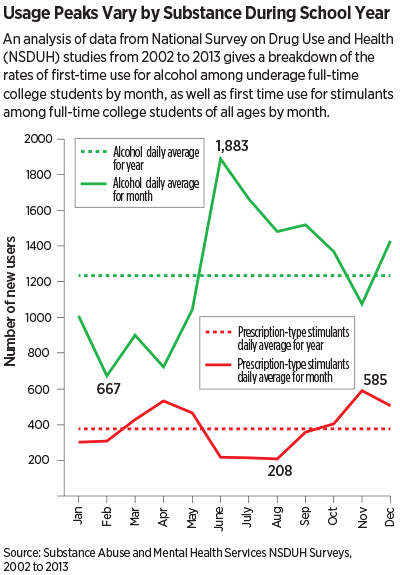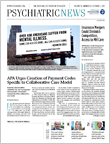A new study by the Substance Abuse and Mental Health Services Administration (SAMHSA) shows that summer months and the periods surrounding final examinations may be the riskiest times for college students to initiate illicit substance use.
“Illicit drug and alcohol use are common practices for many college students with about 1 out of every 5 full-time college students aged 18 to 22 having used illicit drugs in the past month and over half having drunk alcohol,” wrote Rachel Lipari, Ph.D., a statistician at SAMHSA’s Center for Behavioral Health Statistics and Quality and author of the report. “However, less is known about initiation of substance use by college students, particularly about monthly variations in initiation.”
Lipari’s analysis, which included combined data from the National Survey on Drug Use and Health (NSDUH) studies from 2002 to 2013, examined the average number of full-time college students using illicit substances for the first time per day for the year, broken down by month.
The results showed that when it comes to alcohol use, 450,000 underage full-time college students (aged 18 to 20) started drinking in the past year, which Lipari calculated to be around 1,200 students per day on average throughout the year. Underage drinking initiation peaked among those students in June, with an average of 1,883 underage college students starting to drink each day of that month. Alcohol use is defined as having more than a sip or two from a can or bottle of beer, a glass of wine or a wine cooler, a shot of liquor, or a mixed drink containing liquor.
The month of June also reigned as the riskiest month for first-time marijuana use, with approximately 1,500 students using marijuana for the first time each day (around 500 more students initiating use daily than the average for the year). June was also the most popular month for college students to have a first-time experience with inhalants such as nitrous oxide, amyl nitrite, cleaning fluid, and gasoline, with around 300 college students trying them for the first time (around 100 more students per day than the daily average for the year).
First-time nonmedical use of prescription-type pain relievers and stimulants by college students peaked in the winter months; an average of 850 students reported the nonmedical use of pain relievers per day in December (around 150 more students initiating use daily than the average for the year) and an average of 585 students per day initiated stimulant use in November (about 180 more new users per day than the average for the year).
“Although initiation of substance use can occur at any time, the summer months remain a period of unique vulnerability for young people,” Lipari wrote. “Intensifying parental monitoring or substance use prevention messaging during these peak months of initiation may amplify their impact.”
Although the report was not designed to determine the cause behind the trends in the initiation of illicit substance abuse, Lipari noted that the uptick in first-time use of prescription stimulants for nonmedical use coincides with the times of the year that many college midterm and final exams occur. This timing, she added, may indicate that some full-time college students start nonmedical use of prescription stimulants in the belief that the drugs might enhance their academic performance. (Nonmedical use of stimulants has not been proven to improve academic performance and can pose serious medical risks, according to SAMHSA.)
“Although college is a period of life when young people try many new experiences, substance use initiation during college is not a ‘rite of passage’ during the transition to adulthood,” Lipari wrote. “Providing college students with credible and accurate information about the harm associated with substance use is crucial to prevention programming,” she concluded. ■
“Monthly Variation in Substance Use Initiation Among Full-Time College Students” can be accessed
here.

